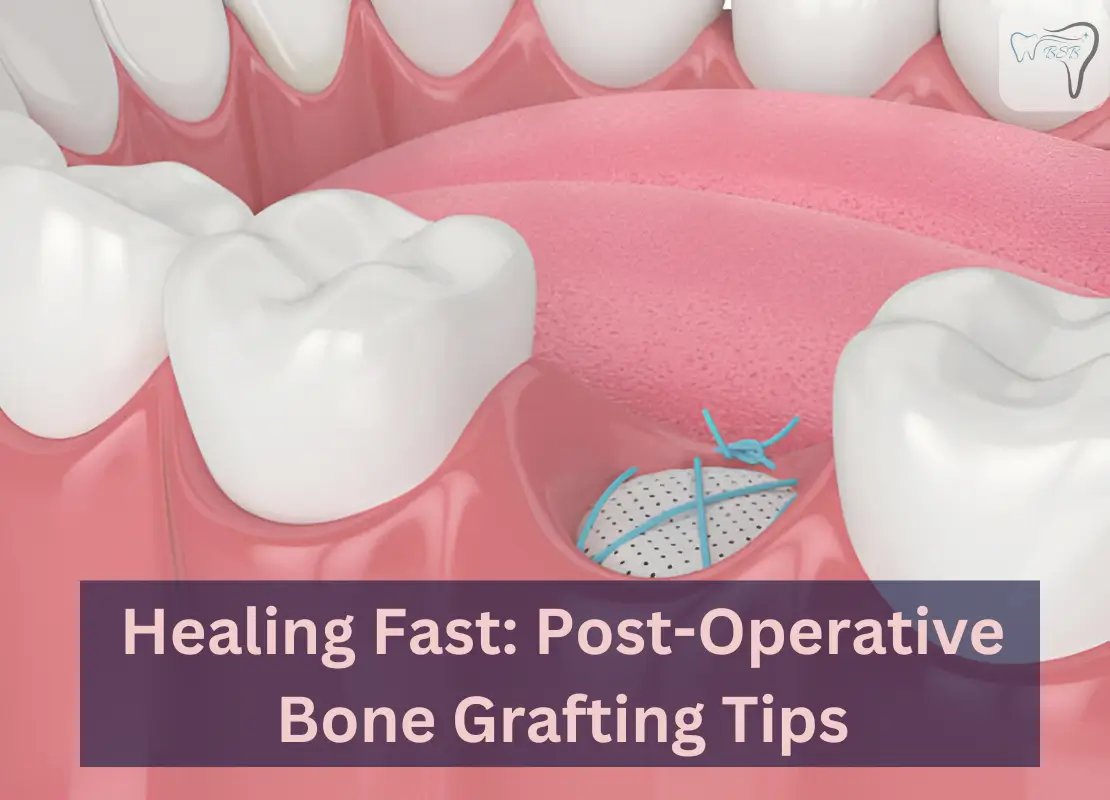After a surgical bone graft, you may notice small granules in your mouth—this is normal. Avoid spitting or vigorous rinsing for the first few days to prevent dislodging particles from the graft site. Be cautious around the wound, especially if there are sutures.
This procedure helps to preserve your jaw for future implant or tooth pain replacement, so follow all post-op instructions carefully to maintain the bone’s shape and contours.There are some things you can do to minimize the number of particles that become dislodged:
- Avoid touching or disturbing the wound to prevent irritation and promote healing.
- Refrain from rinsing or spitting for the first 48 hours to help stabilize the graft material and allow the blood clot to form properly.
- Do not press on the graft site with your tongue or fingers, as the bone particles are delicate and can shift during early healing.
- Avoid pulling on your lip to check the sutures, as this can cause damage to the wound and disrupt the healing process.
- Smoking should be avoided, as it can slow healing and increase the risk of complications.
- For mild pain, take over-the-counter medications such as Tylenol® or ibuprofen every 3–4 hours.
- If you experience more intense pain, use any prescribed medication as directed.
After the second day, you can begin gentle rinsing, but avoid doing it too vigorously to prevent disturbing the bone graft granules. If you have a partial denture or flipper in your mouth, it may require an adjustment from your restorative dentist. You’ll also need to learn how to properly remove and replace it to ensure the healing process continues smoothly.
Diet
After bone graft surgery, you may feel numbness from the local anesthesia, so start with soft foods like a smoothie or milkshake, but avoid a straw. Stick to cool items to prevent a burn while the tissue heals. Eat things like pancakes with syrup, macaroni and cheese, or soft eggs.
Drink plenty of fluids, but avoid hot ones. Gradually, you can add softer meals like spaghetti or other pastas, but take care to avoid the surgical sites. Resume your normal diet when tolerated, but healing may take longer for some.
To Reduce Swelling
To reduce swelling after surgery, keep your head elevated with 2 pillows while lying down or sitting semi-reclined in a reclining chair. Apply ice packs to your face for 30 minutes on, then 30 minutes off, during the first 48 hours.
Alternate between the right and left sides every 20 minutes to avoid tissue injury. After the initial 24 hours, use warm compresses. Swelling is normal and typically reaches its maximum around 48 hours.
Rinsing
It’s recommended to allow the blood clot to settle by avoiding any forceful rinsing or spitting for 3–5 days. Starting the day after surgery:
- You can gently brush the adjacent tooth surfaces, ensuring that the brush does not disturb the graft site.
- Refrain from putting pressure on the grafted area with your tongue or fingers, as the material can shift during the initial healing period.
- Avoid lifting or pulling your lip to check the sutures, as this can cause damage to the wound site and may tear the stitches.
Denture or Flipper
On the day of your surgery, you will receive detailed instructions about when and how to wear your denture or flipper. Some possible guidelines may include:
- Denture or Flipper should be left out of your mouth until you are instructed to wear it, as it may need to be realigned before use.
- Denture or Flipper can remain in place for 48 hours, after which it should be removed. Follow your doctor’s instructions carefully regarding its use.
- Always wear your denture or flipper exactly as instructed by your doctor to ensure proper fit and healing.
- If any sores or swelling develop around or under the denture or flipper, remove it immediately and contact the office.
- If you are unable to place the denture or flipper back in your mouth, leave it out and call the office for further instructions.
Bruising
Bruising can sometimes appear 24 or 48 hours after surgery. To help speed up the healing process, apply warm compresses to the involved area for 30 minutes on, followed by 30 minutes off. This method will help expedite recovery and reduce discomfort.
What to Do If Bleeding Persists
If bleeding occurs after your surgery, fold a piece of gauze into quarters to form a firm pad. Place it on the surgical site and apply pressure by either biting down or using direct finger pressure. Ensure the pad is positioned correctly, not just between your teeth.
If needed, repeat the procedure until the bleeding stops, usually within 2-3 hours, though some blood-tinged saliva may persist for up to 24-48 hours. If it continues after 2 hours, use a moistened tea bag, bite down for 30 minutes, and apply pressure. If the bleeding remains uncontrolled, contact your doctor.
Pain Management
After oral surgery, you may feel some discomfort. To manage acute pain, start with over-the-counter pain medications as directed by your surgeon. If the pain becomes more intense, you might need a stronger prescribed option. You can alternate between pain relievers every 4-6 hours if necessary.
Always take your medication with food to reduce the chance of nausea, and avoid combining them with substances like alcohol, benzodiazepines, or other depressants, as this can increase the risk of an accidental overdose.
If you’re unable to achieve a comfortable state, please call us for further advice.In cases of infection, remember that dentists safely remove infected teeth to prevent complications and ensure proper recovery
Antibiotics After Bone Grafting: What You Need to Know
After your bone grafting procedure, your doctor may have prescribed antibiotics to help prevent infections at the surgical site. It’s crucial to take this medication as directed, even if you feel better, to avoid complications. Missing doses or stopping too early can lead to a higher risk of infection or adverse reactions.
If you experience mild side effects like nausea, rash, or itching, you should inform your doctor, but these symptoms can often be managed with antihistamines.However, if you notice more serious signs of an allergic reaction such as hives, swelling of the lips or tongue, or difficulty breathing, stop taking the medication and seek medical attention immediately.
In some cases, patients receive an intravenous dose of antibiotics during the procedure, but oral antibiotics may still be necessary afterward to ensure full protection against infection. Always follow your doctor’s instructions closely for the best recovery outcome.
Infection
Even though antibiotics are often given to help prevent infection, there is still a chance that a wound infection can develop after surgery. Signs of an infection might include a sudden increase in swelling, throbbing pain, or the presence of foul-tasting drainage from the wound. If you notice these symptoms, it’s important to contact your doctor as soon as possible to avoid further complications.
Activity and Smoking/Vaping
After oral surgery, it’s important to keep physical activity limited for the first 2 weeks to help with healing. Avoid vigorous exercise and organized sports until at least 3-5 days after the procedure or as your condition allows. If you need a written excuse for gym class or sports, please contact our office.
Additionally, avoid using tobacco, alcohol, and especially refrain from smoking or vaping, as the nicotine can severely delay healing and may cause an increase in post-operative pain. Staying away from these activities will help ensure a smoother recovery and help your mouth stay numb during the initial healing phase.
Graft Material
The material used for the graft is either donated bone or synthetic bone. These grafts are often over-packed with excess material, which can cause gritty graft particles to fall from the socket and may feel like sand when you bite. This is completely normal.
Membrane
The membrane is a thin collagen sponge used to cover the graft and help stabilize it. It is common for the membrane to come off within 1-3 days after the procedure.
Oral Hygiene
For proper oral hygiene after bone grafting, start using a plastic irrigating syringe 3 days after extraction to gently irrigate the lower extraction site(s) and remove food debris. Avoid Listerine®, Scope®, or any over-the-counter mouthwash to prevent irritating the surgery site. Instead, use Peridex three times daily, especially after breakfast and before bed, making sure to rinse 30 seconds before spitting out.
Clean around the graft with a cotton swab (Q-Tip) moistened with Peridex. Avoid electric toothbrushes until cleared by your surgeon. Rinse with warm salt water (teaspoon of salt in water) at least 4-5 times a day after meals. Be gentle when brushing teeth, and use Peridex instead of toothpaste for the first few days. Do not gargle, and expect some traces of blood during recovery.
Your Guide to Perfect Stitch Care!
After a bone grafting procedure, you might notice that the stitches in your mouth are dissolvable and will typically fall out on their own within about 4 days, though sometimes it takes a bit longer. It’s not unusual for them to loosen and come out prematurely, especially in moving areas like the tongue or cheek areas.
If this happens and the wound opens, creating a small hole, there is usually no need for concern unless you experience excessive bleeding. Fortunately, oral incisions heal quickly, and any wound that opens will generally close naturally. In my experience, staying calm and following your dentist vs. oral surgeon: who’s best advice helps ensure a smooth recovery.
When You Arrive Home
- Remove any gauze packing from the mouth.
- Consume at least a quarter of your milkshake or smoothie using a spoon instead of a straw.
- Administer a pain reliever immediately as per the “Pain Management” instructions, unless ibuprofen was already provided during recovery.
- Take the antibiotic, if it has been prescribed, as per the directions.
- Replace gauze packing, if it becomes necessary.
- Begin applying ice packs to the outside of your face for no more than 20 minutes per side, as previously explained.
- Increase your overall fluid intake throughout the day.
Conclusion
For simple extractions, a dentist is sufficient, but for complex cases like impacted teeth, an oral surgeon is recommended. Oral surgeons are specially trained for difficult extractions and advanced anesthesia. Always consult your provider to determine the best option.

